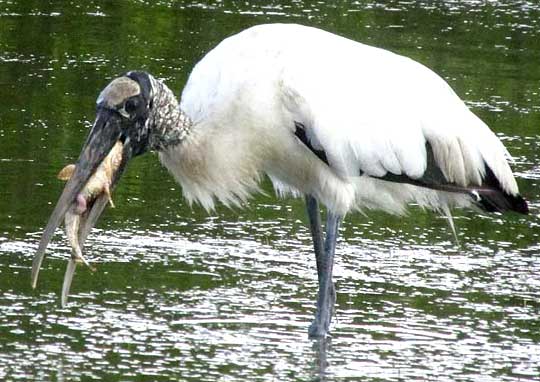Excerpts from Jim Conrad's
Naturalist Newsletter
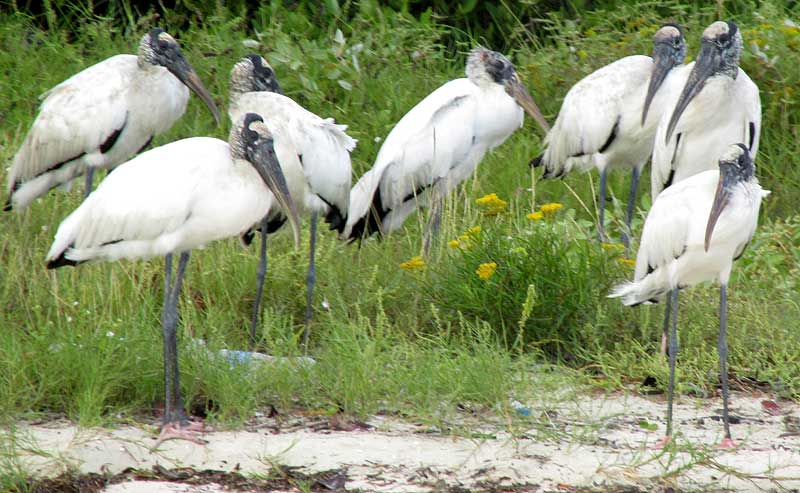
from the November 2, 2014 Newsletter issued from Río Lagartos, on the Yucatan Peninsula's northern coast (~N21.60°, ~W88.16°), Yucatán state, MÉXICO
WOOD STORKS
In a boat in the estuary you can get closer to shorebirds than if you were on land. That's how I got the picture of the Wood Storks, MYCTERIA AMERICANA, shown above.
These are big birds, standing 33-45 inches tall (83-115cm), with wingspans of 55-71 inches (140-180cms). Seventy-one inches is 5.9 feet (1.8m). With their large size, featherless heads and necks, and massive beaks they give the impression of being very primitive. However, gene sequencing data and the fossil record don't much support that idea. Early in bird evolution stork ancestors claimed an ecological niche, exploited it, stayed in it, and through the ages have been evolving just like all other organisms. When a set of adaptations such big size, long legs, naked head and huge beak serve their purpose well, they are retained, even if they look out of date to human eyes.
In the 2010 book Storks, Ibises and Spoonbills of the World, James Hancock and others write that members of the stork tribe Mycteriini, to which Wood Storks belong, find food less with their eyes than with touch. Also, when they submerge their large, cylindrical, slightly downcurved bills they hold them open for fish to swim into. To encourage fish to swim into their open beaks they may pump their feet, flash their wings and do other fish-upsetting things.
However, in early morning, on the muddy banks of the canal cut through the barrier island in front of Río Lagartos, our Wood Storks weren't doing any of that. They were just hanging out warily watching one fishing boat after another putt-putt through the channel out to sea and they hardly seemed to care that our boat got close enough for the above picture.
Wood Storks are the only stork species currently breeding in North America. In the US small breeding populations are maintained in Florida, Georgia, South Carolina, and North Carolina. For thirty years conservationists have been trying to increase the US population, and they've had such success that Wood Storks were removed from the endangered species list and upgraded to threatened just this year, on June 26, 2014.
Wood Storks are mostly tropical American birds occurring along both Mexican coasts and all across the Yucatan Peninsula, and farther south through Central America to western Ecuador and northern Argentina. It's thought that the species arose in the tropics, and that they moved into North America only after the last ice age.
Our Wood Stork is different from Europe's chimney-nesting, baby-delivering White Stork, which belongs to an entirely different genus. White Storks have white-feathered heads and necks, and red beaks
from the June 29, 2007 Newsletter issued from Sierra Gorda Biosphere Reserve Headquaraters in Jalpan, Querétaro, MÉXICO
WANDERING WOOD STORKS
When the rain ended a couple of hours later I packed up, walked around the corner, and there was a flock of Wood Storks feeding in shallow water next to a mudflat. You can see the very ones, with several smaller, white, immature Little Blue Herons over at the right, below:
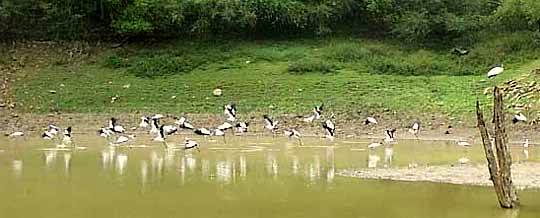
These are fairly big birds, with wingspans of over five feet. I'd seen occasional Wood Storks at the reservoir before but never in such numbers. The picture shows only part of them; later a flock of about 40 birds flew by. Probably the reason they're not here most of the year is the lack of habitat. Only when the reservoir's water is very low, with lots of level mud exposed, can they forage the way they like to, wading in shallow water and probing with their long beaks.
You can't look at a stork without thinking "primitive." Especially because of the black, featherless head and neck you can almost feel the dinosaur in them. I grew up with the notion that storks were presented early in field guides because they were among the first bird- groups to evolve, while perching birds appeared in the field guide's backs because they're so recently evolved. This concept has changed.
One current idea of the "Bird Evolutionary Tree" is at https://www.scientificamerican.com/article/graphic-science-the-bird-family-tree-gets-a-makeover/.
"Evolutionary trees" such as the above give us an idea of the path evolution took as the various bird groups arose. Such trees are based on the assumption that "the more genes two taxa share, the more closely related the taxa are."
Another assumption about evolutionary trees is that the fewer branches occurring between the tree's root and a final group of organisms at the end of a branch, the more primitive that group is. A group appearing only after many branchings is regarded as having arisen relatively recently. For this to be true in all cases it's necessary for evolution to have proceeded at a constant rate across all taxa. That's not necessarily the case, however, so trees such as the one shown above must be regarded as only good guesses.
Remembering the limitations, then, the above tree suggests that kiwis, ostriches, ducks and woodpeckers are relatively primitive, but pelicans and loons, our storks, herons, ibises and spoonbills, no mater how primitive they may look, are actually pretty modern. Perching birds, or Passeriforms, appear near the middle of the tree, so that group is neither particularly primitive nor modern.
If you'd like to understand evolutionary trees better, a great place to learn the basics is at Berkeley's http://evolution.berkeley.edu/evolibrary/article/phylogenetics_01.
from the December 28, 2014 Newsletter issued from Río Lagartos, on the Yucatan Peninsula's northern coast (~N21.60°, ~W88.16°), Yucatán state, MÉXICO
WOOD STORK CATCHES A FISH
Our Flamingo-watching boat was passing a Wood Stork staring penetratingly into the shallow water before him, not flying away despite our nearness. We saw why he tarried when he ran forward a few steps and stabbed his big beak into the mostly submerged mass of Widgeongrass, and withdrew a squirming, catfish-shaped fish, as shown below:
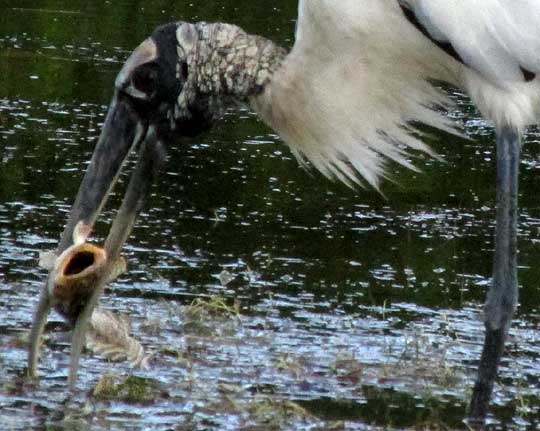
Again and again the stork jerked back his head, briefly releasing the pressure on the fish so it'd shift into a new position, then he'd clamp down hard again, probably breaking a few of the poor fish's bones in the process. From our distance the fish looked like a Banded Blenny, Paraclinus fasciatus, a common tropical species of shallow, salty water in the northern and central Western Atlantic.
Two or three times the fish slipped free, but the stork just snatched him up again. Several minutes passed until the fish was subdued enough for the big bird to begin orienting it in his beak so that the fish's head pointed toward the gullet, as shown below:
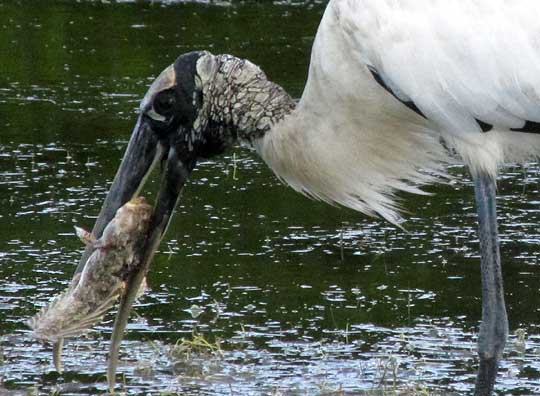
The moment before the stork raised his head and the fish slipped into oblivion is shown below:
